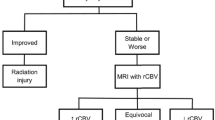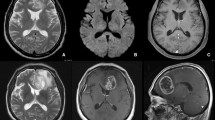Abstract
To describe the morphologic magnetic resonance imaging (MRI) findings in histologically proven therapy-induced cerebral necrosis. We retrospectively reviewed the morphologic MRI findings in patients with therapy-induced cerebral necrosis. Images were reviewed for size, location, and characteristics of signal intensity abnormalities and T1-contrast enhancement. Images were also assessed for mass effect, necrosis, cyst, atrophy, cortical thinning, and leukoencephalopathy. The individual imaging characteristics were correlated with clinical and treatment variables. There were 44 patients. Seventy percent had a glioma, all patients had received radiation, and 57% had received chemotherapy in close proximity to radiation. All images demonstrated contrast enhancement, predominantly in the white matter. Enhancement was present in the periventricular/subependymal region in 50% of cases and the corpus callosum in 27%. The most common pattern of lesion peripheral enhancement was “spreading wavefront” and of interior enhancement was “Swiss cheese/soap bubble.” The enhancing lesion was single in 60% of cases. Mass effect was present in 93% of patients. Location and patterns of enhancement were significantly associated with the interval from brain radiation to the diagnosis of therapy-induced cerebral necrosis, tumor histology, patient age, type of radiation, and administration of systemic chemotherapy. This is the largest study of the morphologic conventional MRI findings in pathologically confirmed therapy-induced cerebral necrosis. We characterized the imaging findings in a variety of tumor types following a variety of radiation treatments and other antineoplastic therapy. These findings may be of value in identifying therapy-induced cerebral necrosis in patients treated for a brain tumor.



Similar content being viewed by others
References
Marks JE, Baglan RJ, Prassad SC, Blank WF (1981) Cerebral radionecrosis: incidence and risk in relation to dose, time, fractionation and volume. Int J Radiat Oncol Biol Phys 7:243–252
Calvo W, Hopewell JW, Reinhold HS, Yeung TK (1988) Time- and dose-related changes in the white matter of the rat brain after single doses of X rays. Br J Radiol 61:1043–1052
Mahaley MS Jr, Vogel FS, Burger P, Ghatak NR (1977) Neuropathology of tissues from patients treated by the Brain Tumor Study Group. Natl Cancer Inst Monogr 46:7–82
Chan YL, Leung SF, King AD, Choi PH, Metreweli C (1999) Late radiation injury to the temporal lobes: morphologic evaluation at MR imaging. Radiology 213:800–807
Suzuki S, Nishio S, Takata K, Morioka T, Fukio M (2000) Radiation-induced brain calcification: paradoxical high signal intensity in T1-weighted MR images. Acta Neurochir 142:801–804
Mishima N, Tamiya T, Matsumoto K, Furuta T, Ohmoto T (2003) Radiation damage to the normal monkey brain: experimental study induced by interstitial irradiation. Acta Med Okayama 57:123–131
Peterson K, Clark HB, Hall WA, Truwit CL (1995) Multifocal enhancing magnetic resonance imaging lesions following cranial irradiation. Ann Neurol 38:237–244
Coderre JA, Morris GM, Micca PL, Hopewell JW, Verhagen I, Kleiboer BJ, van der Kogel AJ (2006) Late effects of radiation on the central nervous system: Role of vascular endothelial damage and glial stem cell survival. Radiat Res 166:495–503
Kumar AJ, Leeds NE, Fuller GN, Tassel P, Maor MH, Sawaya RE, Levin VA (2000) Malignant gliomas: MR imaging spectrum of radiation therapy- and chemotherapy-induced necrosis of the brain after treatment. Radiology 217:377–384
Mullins ME, Barest GD, Schaefer PW, Hochberg FH, Gonzaleza RG, Lev MH (2005) Radiation necrosis versus glioma recurrence: conventional MR imaging clues to diagnosis. AJNR 26:1967–1972
Ross DA, Sandler HM, Balter JM, Hayman JA, Archer PG, Auer DL (2002) Imaging changes after stereotactic radiosurgery of primary and secondary malignant brain tumors. J Neurooncol 56:175–181
Taal W, Brandsma D, de Bruin HG, Bromberg J, Swaak-Kragten A, Sillevis Smitt P, Van Es CA, Van Den Bent MJ (2008) Incidence of early pseudo-progression in a cohort of malignant glioma patients treated with chemoirradiation with temozolomide. Cancer 113:405–410
Disclosures
The authors report no financial relationships, sponsorships, or affiliations.
Author information
Authors and Affiliations
Corresponding author
Rights and permissions
About this article
Cite this article
Rogers, L.R., Gutierrez, J., Scarpace, L. et al. Morphologic magnetic resonance imaging features of therapy-induced cerebral necrosis. J Neurooncol 101, 25–32 (2011). https://doi.org/10.1007/s11060-010-0222-9
Received:
Accepted:
Published:
Issue Date:
DOI: https://doi.org/10.1007/s11060-010-0222-9




